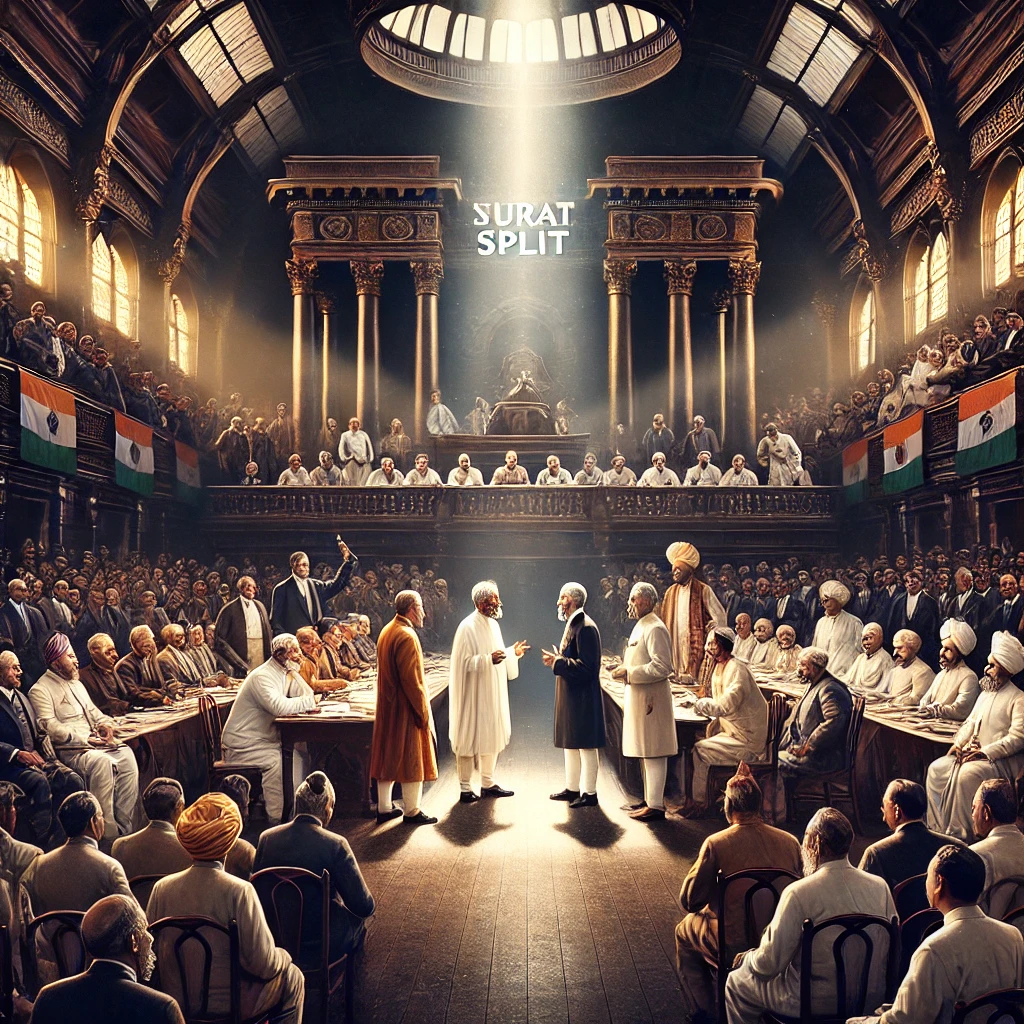The Indian freedom movement witnessed several crucial moments that shaped its course, and one such significant event was the Surat Split of 1907. This internal division within the Indian National Congress (INC) between the Moderates and the Extremists played a crucial role in defining the future strategies of the Indian independence struggle. The split not only exposed ideological differences among the leaders but also influenced the way nationalist politics evolved in the years to come.
Background of the Surat Split
1. Rise of Nationalist Sentiments
The late 19th and early 20th centuries saw a rise in Indian nationalism due to factors like:
- Economic exploitation by the British (Drain of wealth, high taxes, and exploitation of Indian industries).
- Increased political awareness through the efforts of the Indian National Congress.
- Partition of Bengal (1905), which intensified nationalist anger against British policies.
- Emergence of two groups within the Congress – Moderates (who believed in constitutional reforms) and Extremists (who believed in direct action).
2. Indian National Congress: Growing Differences
The Indian National Congress (INC) was founded in 1885, initially dominated by leaders who followed a moderate approach. However, by the early 1900s, a new wave of nationalist leaders emerged, advocating for more aggressive and direct actions against British rule.
Two Factions within the Congress
| Moderates | Extremists |
|---|---|
| Led by Gopal Krishna Gokhale, Dadabhai Naoroji, and Surendranath Banerjee. | Led by Bal Gangadhar Tilak, Bipin Chandra Pal, and Lala Lajpat Rai. |
| Advocated constitutional methods, petitions, and dialogues with the British. | Advocated agitation, boycotts, and mass movements. |
| Believed in gradual reforms through cooperation with the British. | Believed in Swaraj (self-rule) through direct action. |
| Relied on British goodwill for reforms. | Had no faith in British rule and wanted immediate freedom. |
These ideological differences eventually led to an open confrontation in 1907 at the Surat session of the Congress.
The Surat Session (1907): The Breaking Point
The Congress session was held in Surat, Gujarat, in December 1907. The differences between the Moderates and Extremists had already been escalating over the previous years, but the situation reached its peak at this session.
Key Issues Leading to the Split
- Presidential Candidate Dispute
- The Moderates wanted Rash Behari Ghosh as the Congress President.
- The Extremists wanted Bal Gangadhar Tilak to be the President.
- This dispute led to tensions within the party.
- The Moderates wanted Rash Behari Ghosh as the Congress President.
- Methods of Protesting Against British Rule
- The Extremists wanted a more radical approach, including boycotts, protests, and self-reliance.
- The Moderates insisted on constitutional means and gradual reforms.
- The two sides could not reach a compromise.
- The Extremists wanted a more radical approach, including boycotts, protests, and self-reliance.
- Personal Clashes and Hostility
- The session turned chaotic as both factions started shouting slogans.
- A physical altercation broke out among members.
- The Moderates expelled the Extremists from the Congress.
- The session turned chaotic as both factions started shouting slogans.
Thus, the Congress officially split into two groups – Moderates and Extremists – marking the Surat Split of 1907.
Impact and Significance of the Surat Split
1. Weakening of the Nationalist Movement
The split weakened the unity of the national movement, allowing the British to exploit the divisions. The lack of a unified leadership slowed down the struggle for independence for the next few years.
2. British Policy of ‘Divide and Rule’ Strengthened
The British government took advantage of the split by:
- Favoring the Moderates and granting minor reforms to keep them satisfied.
- Suppressing the Extremists through arrests, deportations, and imprisonments.
- Passing the Morley-Minto Reforms (1909), which gave minor political concessions but introduced separate electorates for Hindus and Muslims, further dividing Indian society.
3. Extremists Faced Harsh Repression
After the split:
- Bal Gangadhar Tilak was arrested (1908) and sent to Mandalay jail for six years.
- Other Extremist leaders, Lala Lajpat Rai and Bipin Chandra Pal, were also arrested or forced into exile.
- The Extremist movement weakened temporarily due to leadership vacuum.
4. Moderates’ Influence Declined
- The Moderates lost public support as their constitutional methods seemed ineffective.
- They failed to stop British repression against Bengal’s anti-partition movement.
- Their influence in the Congress gradually declined after 1915.
5. Rise of a More Militant Nationalist Movement
Though the Surat Split weakened Congress, it also laid the foundation for a more militant nationalist movement:
- Young revolutionaries like Bhagat Singh, Chandrashekhar Azad, and Subhas Chandra Bose emerged, inspired by Extremist leaders.
- Non-cooperation Movement (1920) and Civil Disobedience Movement (1930) were later influenced by the Extremist ideology.
6. Reunification of Congress (1916)
By 1916, both Moderates and Extremists realized the importance of unity. With the Lucknow Pact, the Congress was reunited, and both factions worked together under Mahatma Gandhi’s leadership in the coming years.
Conclusion
The Surat Split of 1907 was a significant turning point in India’s struggle for independence. It marked the first major ideological division within the Indian National Congress, highlighting the conflicting strategies for achieving freedom. While it temporarily weakened the nationalist movement, it also paved the way for more aggressive forms of resistance in later years.
The division between Moderates and Extremists ultimately contributed to the evolution of India’s freedom movement, showing that the path to independence would require both diplomatic efforts and mass revolutionary action. The lessons from the Surat Split helped shape future nationalist strategies, eventually leading to India’s independence in 1947.




